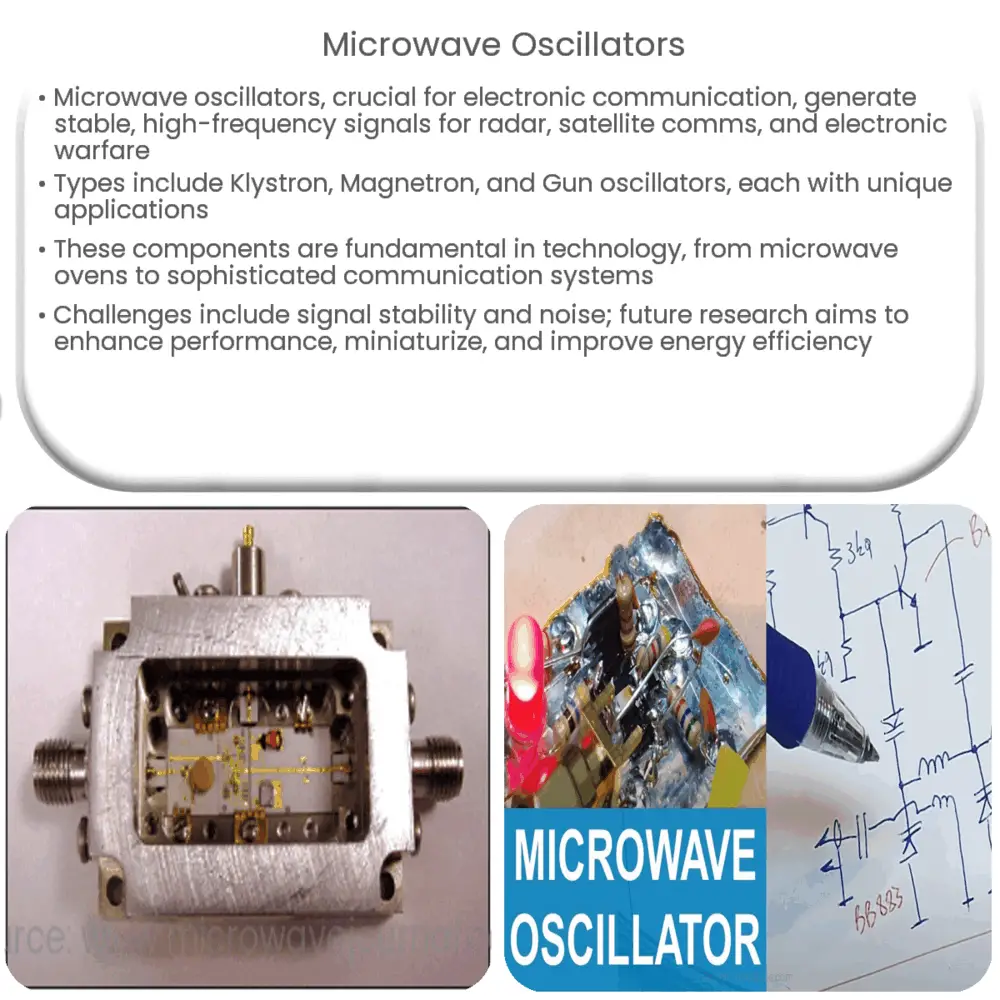Explore the world of microwave oscillators, their types, role in technology, challenges, and future potential in our comprehensive guide.

Microwave Oscillators: An Essential Component in Modern Technology
Microwave oscillators are a critical component in the field of electronics and communication, playing a vital role in applications like radar systems, satellite communication, and electronic warfare. The heart of a microwave oscillator is the feedback loop, capable of generating stable, high-frequency signals.
Understanding the Basics
Microwave oscillators are devices that generate oscillating electric fields or electromagnetic waves that lie within the microwave frequency range (1 GHz to 300 GHz). An oscillator, by definition, is an electronic circuit capable of producing a repetitive waveform. In microwave oscillators, these waveforms are at microwave frequencies. Essentially, these devices are tunable, allowing them to generate signals at different frequencies.
Types of Microwave Oscillators
- Klystron Oscillator: Klystron Oscillators are a type of microwave vacuum tube. The electron beam from the cathode is speed-controlled before it enters the resonating cavities where the electric signal is amplified. It is widely used in broadcasting and radar technology.
- Magnetron Oscillator: This type of oscillator works under the influence of both electric and magnetic fields. The magnetron is used predominantly in microwave ovens and radar technology due to its ability to produce large amounts of power.
- Gun Oscillator: Also known as backward wave oscillators, they exploit the interaction between an electron beam and a slow-wave structure to produce oscillations. Gun oscillators are particularly known for their wide bandwidth.
The Role of Microwave Oscillators in Technology
The importance of microwave oscillators can’t be overstated. They play a crucial role in radar systems used for navigational purposes and in weather prediction. In radar systems, they produce the high-frequency signal that gets transmitted into the atmosphere, and the returned signal is analyzed to identify objects and their location.
Moreover, microwave oscillators are also used in satellite communication systems. They generate the carrier wave required for transmitting information. Notably, satellite TV systems and various types of wireless communication systems employ microwave oscillators for their operation.
In electronic warfare, microwave oscillators are used to jam enemy signals or to intercept and decode enemy communication. This ability to interfere with enemy signals has proven crucial in modern warfare scenarios.
Finally, the most commonplace application of microwave oscillators is in microwave ovens. The magnetron oscillator within the oven generates microwaves that cause the water molecules in food to vibrate, producing heat and thus cooking the food.
Design and Operation of Microwave Oscillators
Microwave oscillators are designed to provide the desired output while minimizing signal noise. An oscillator typically consists of an amplifier for boosting the signal and a feedback loop for ensuring the stability of the output signal. In terms of operation, the feedback signal from the output is continually fed back into the input to maintain oscillation.
It is important to note that microwave oscillators must be finely tuned to generate the desired frequency. Any deviation from the set frequency could lead to inaccurate or inefficient results in the applications they are used in.
Challenges and Future Developments
As critical as microwave oscillators are, they come with their set of challenges. Signal stability and noise are among the significant issues to overcome. Since microwave frequencies are high, maintaining the stability of the generated signal can be a task. Moreover, noise generated during oscillation can interfere with the signal, affecting the accuracy of the data transmitted or received.
Future advancements in microwave oscillator technology are focused on improving signal stability, reducing noise, and increasing power efficiency. Moreover, as technology continues to evolve, there’s a drive to make these components smaller and more lightweight without compromising their performance.
Conclusion
In conclusion, microwave oscillators are a fundamental part of modern communication and electronic systems. Their ability to generate stable, high-frequency signals has found applications in a wide array of fields – from household appliances to sophisticated satellite communication systems and radar technology.
The future holds significant potential for the evolution of these vital components, with ongoing research focusing on enhancing their performance while making them more compact and energy-efficient. As the demand for high-speed, high-frequency communications increases, so does the importance of microwave oscillators, underscoring their continued relevance in the realm of electronics and communication.

